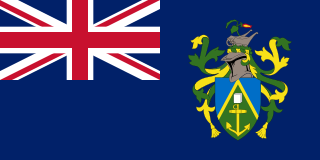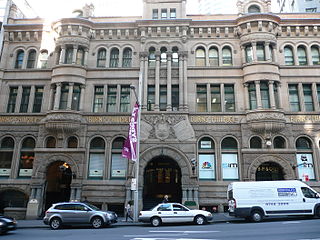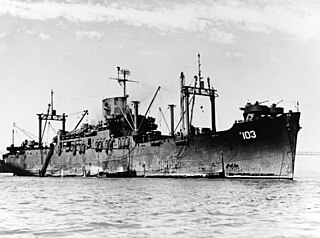
The Pitcairn Islands, officially the Pitcairn, Henderson, Ducie and Oeno Islands, are a group of four volcanic islands in the southern Pacific Ocean that form the sole British Overseas Territory in the Pacific Ocean. The four islands—Pitcairn, Henderson, Ducie and Oeno—are scattered across several hundred miles of ocean and have a combined land area of about 18 square miles (47 km2). Henderson Island accounts for 86% of the land area, but only Pitcairn Island is inhabited. The islands nearest to the Pitcairn Islands are Mangareva, 688 km to the west, and Easter Island, 1,929 km to the east.
USS Hyperion (AK-107) was a Crater-class cargo ship in the service of the US Navy in World War II. Named after Saturn's moon Hyperion, she is the only ship of the Navy to bear this name.

Burns Philp was a major Australian shipping line and merchant that operated in the South Pacific. When the well-populated islands around New Guinea were targeted for blackbirding in the 1880s, a new rush for labour from these islands began. James Burns and Robert Philp purchased several well-known blackbirding ships to quickly exploit the human resource in this region, and Burns Philp entered the slave trade. The company ended its involvement in blackbirding in 1886. In later years the company was a major player in the food manufacturing business. Since its delisting from the Australian Securities Exchange in December 2006 and the subsequent sale of its assets, the company has mainly become a cashed up shell company. It is wholly owned by Graeme Hart's Rank Group.

The USS Alnitah (AK-127) was a Crater-class cargo ship in the service of the US Navy in World War II. Named a spelling variation of the star Alnitak in the constellation Orion, it was the only ship of the Navy to bear this name.

USS Zebra (AKN-5) was an Indus-class net cargo ship in the service of the United States Navy in World War II. The ship was originally the Matthew Lyon, an EC2-S-C1 Liberty ship, operated for the War Shipping Administration (WSA) as a cargo vessel by an agent until severely damaged by torpedo in August 1943. While at Espiritu Santo in the New Hebrides awaiting likely scrapping the Navy acquired the vessel under bareboat charter to be used as a net cargo ship transporting reclaimed anti-submarine netting.

MS Klipfontein was a Dutch ocean liner launched in March 1939 and delivered 29 July intended for South African service. Declaration of war in Europe, including Britain and South Africa declaring war on Germany, resulted in the ship being transferred to service between the Dutch East Indies and the west coast of North America. After the German invasion of the Netherlands in May 1939, with the Dutch government in exile in London, the ship supported the Allied war effort. After entry of the United States into the war the ship was operated by Dutch agents of the U.S. War Shipping Administration (WSA) from February 1942 to February 1946 as a troopship from the U.S. West Coast to Pacific war zones.

USS Mizar (AF-12) was the United Fruit Company fruit, mail and passenger liner Quirigua that served as a United States Navy Mizar-class stores ship in World War II.

USS Uranus (AF-14) was a Uranus-class stores ship bareboat chartered to the U.S. Navy by the War Shipping Administration for use in World War II. The ship was one of the Danish vessels idled in U.S. ports seized by the United States after the occupation of Denmark by German forces. The ship was the Danish J. Lauritzen A/S line vessel Maria, ex Caravelle, ex Helga until chartered to the Navy and commissioned on 11 August 1941 under the name Uranus.

USS Talamanca (AF-15) was the United Fruit Company cargo and passenger liner Talamanca that served as a United States Navy Mizar-class stores ship in World War II.

USS Roamer (AF-19) was the Danish refrigerated motorship African Reefer, completed 1935, of the J. Lauritzen shipping company which had put in at Madeira after Germany occupied Denmark. The ship later sailed to a U.S. port on assurances it would be treated equally with U.S. vessels chartered for war purposes. Instead it was seized by the United States Maritime Commission and placed in service under War Shipping Administration (WSA) allotment to commercial, Army transport and finally Navy use at half the rate paid for U.S. ships. The agreed to rate was not restored until 1958 after a Supreme Court judgement and Congressional action.

USS President Polk (AP-103) was a President Jackson-class attack transport in the service of the United States Navy during World War II.

USS George F. Elliott (AP-105) was a cargo liner built for the Mississippi Shipping Company as SS Delbrasil for operation between New Orleans and the east coast of South America in 1939 by its operator, Delta Line. The ship entered that service and operated until taken over by the War Shipping Administration (WSA) on 28 April 1942 for operation by Delta Line acting as WSA's agent. On 25 August 1943 WSA allocated the ship to the Navy for conversion to a troop transport commissioned and operated by the Navy for the duration of the war. Ownership of the ship was transferred from Mississippi Shipping to WSA on 4 February 1944 while under Navy operation and was retained until sale to American South African Lines on 22 December 1948. The ship was renamed African Endeavor until returned as a trade in to the Maritime Commission on 22 September 1960 for layup in the James River reserve fleet and later sold to Boston Metals for scrapping.

The Type C4-class ship were the largest cargo ships built by the United States Maritime Commission (MARCOM) during World War II. The design was originally developed for the American-Hawaiian Lines in 1941, but in late 1941 the plans were taken over by the MARCOM.

SS Point Bonita was constructed in 1918 and launched 27 March 1918 after a hull being built for foreign owners at Albina Engine and Machine Works was requisitioned during World War I by the United States Shipping Board (USSB). The ship saw service as the Navy transport USS Point Bonita, assigned Identification Number 3496, from 7 October 1918 to 7 April 1919, was returned to the USSB and saw civilian service with several commercial companies as San Pedro and Oliver Olson before again seeing service in World War II as USS Camanga (AG-42). After return to commercial service as Oliver Olson the ship was wrecked at the entrance to Bandon harbor in Oregon.

USS Majaba (AG-43/IX-102) was the Design 1049 cargo ship Meriden built in 1919 by the Albina Engine & Machine Works, Portland, Oregon. All the ships were requisitioned by the United States Shipping Board (USSB) for World War I service. The ship was bought by the E. K. Wood Lumber Co., of San Francisco, California in 1923 and renamed El Capitan. The ship was chartered by the U.S. Navy through the War Shipping Administration (WSA) in April 1942 and commissioned as Majaba.

USS Pembina (AK-200) – later known as USNS Pembina (T-AK-200) -- was an Alamosa-class cargo ship that was constructed for the U.S. Navy during the closing period of World War II. She supported the end-of-war Navy effort and was subsequently placed in service with the US Army under the Shipping Control Authority for the Japanese Merchant Marine with a Japanese crew in Yokosuka, Japan.
SS Haiti was a passenger and freight ship built for the Colombian Mail Steamship Company built at Newport News Shipbuilding, Newport News, Virginia and delivered 15 December 1932. The ship was renamed briefly Puerto Rico in 1938 and Monterey in 1939 to operate for the New York and Cuba Mail Steamship Company until requisitioned with transfer of title to the War Shipping Administration (WSA) on 25 September 1942. The ship was then allocated to the U.S. Army for operation under a bareboat agreement as USAT Monterey. In 1943 the ship was assigned to the command at Trinidad to supply bases in Brazil and Ascension Island. After layup in the reserve fleet the ship was sold to Turkey.

The SS Philippines Victory was the fifth Victory ship built during World War II. She was launched by the California Shipbuilding Company on March 11, 1944, and completed on May 9, 1944. She was built in 113 days under the Emergency Shipbuilding program.
A number of motor vessels that have used the ship prefix M/V have been named Claymore, including:

SS Rufus King was a standard Liberty ship built in the United States during World War II. She was named after Founding Father Rufus King, and was wrecked in July 1942, upon Amity Bar South of Moreton Island and north of North Stradbroke Island, Queensland, Australia. She was operated by International Freighting Corporation under charter with the Maritime Commission and War Shipping Administration.

















